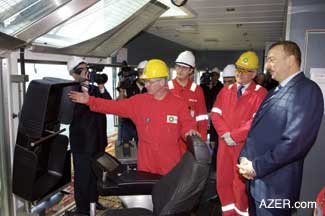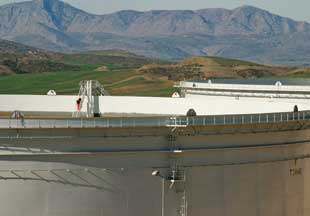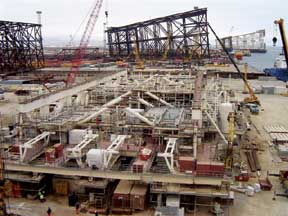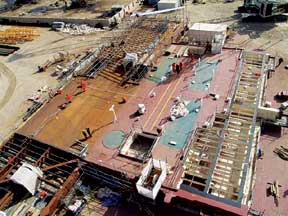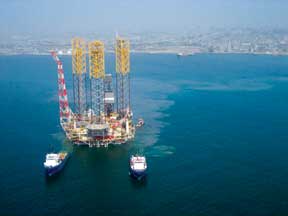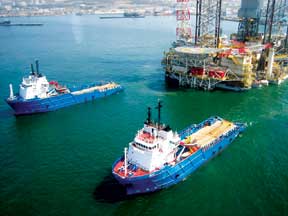|
Above: Construction of the deepwater Gunashli (Phase 3) platforms right on schedule. Photo: BP The SDX-04 well will be drilled to a total depth of more than 7000 meters. The previous three exploration and appraisal wells (SDX-01, SDX-02 and SDX-03) were designed to appraise and delineate the Stage 1 reserves in northern flank of the field. The SDX-04 well will appraise and delineate the resources in the southern flank of the field and will also test for gas presence in deeper horizons. The SDX-04 will take approximately six months to drill and production testing could extend the well's duration by several months in order to confirm the commerciality of the gas reserves in the southern extent of the field. The Stage 1 project is progressing according to schedule to meet the target of delivering first gas to the market before winter 2006. New Caspian Website BP as operator of the Azeri-Chirag-Gunashli (ACG) and Shah Deniz Production Sharing Agreements, the Baku-Tbilisi-Ceyhan (BTC) oil export and South Caucasus Pipeline (SCP) gas export pipeline projects, has recently launched a new external Web site for all these projects. The Web site-BP.com/Caspian-will offer all interested stakeholders information on the long-term operations phase of all these BP-led projects in the Caspian Region, as well as extensive documentation on the projects' construction phase. The new site is now fully navigable in Azeri and English. This, we believe, makes the BP Caspian Web site the largest Azeri-language internet site currently available with more than 300 pages and 10,000 documents. The Web site was designed by Baku-based Jeyhun Imanov Studio. The site provides access to key project documentation such as production sharing and host government agreements, environmental and social impact assessments and action plans, as well as independent monitoring assessments, the BP Azerbaijan Sustainability Report, information on community and environmental invest-ments, career information, news, press releases, pictures and other public reporting documents. East Azeri Jacket Launched The jacket for the East Azeri (EA) production, drilling and quarters (PDQ) platform sailed away on March 11, from the Heydar Aliyev Baku Deepwater Jackets Factory (BDJF). It was launched offshore onto the template at its permanent location in the Azeri field on the next day. The EA PDQ jacket was fully assembled in the country using local construction infrastructure including BDJF facilities. The total weight of the jacket is 15,000 tons. The height of the jacket is 166 meters, and it is being installed at a water depth of 152 meters. The jacket has 12 piles, with a total weight of 7,500 tons.The transportation and installation of the jacket will use a number of SOCAR/KMNF (Khazardenizneftdonanmasi) vessels including the two principal installation vessels - Derrick Barge Azerbaijan (DBA) and STB-1 launch barge. The DBA was further upgraded to undertake the installation work. The jacket transportation activities were also supported by two high capacity tugs-the Islay and the Jura. These are two identical vessels leased from the KMNF / BUE alliance fleet. The tugs were required to tow the STB-1 to the offshore site safely as the jacket's exposed windage area was very high. Other marine vessels involved in towage, anchor handling and supply boat trips were the Nercha, the Pacific Raider, and the Svetlomor-2.  The installation work was expected to take 45-50 days to complete, including allowance for weather conditions.The EA topsides construction is progressing on schedule at the Baku Deepwater Jackets Factory (BDJF) yard with 93 percent of the overall work already complete. The EA topsides offshore hook up and commissioning is planned to be completed in the fourth quarter so that the platform can start-up by the end of 2006. Deepwater Gunashli (Phase 3) Platforms The Phase 3 jackets that are being built at the Baku Deepwater Jackets Factory (BDJF) are designed for 175 meters of water in Deepwater Gunashli - the deepest water, in which we will have oil development operations within the ACG project. The jacket for the drilling, utilities and quarters (DUQ) platform is about 60 percent complete against the plan of 60 percent. The last jacket we have to build for Phase 3 is for the process, gas export compression, water injection and utilities platform (PCWU) and this is approximately 6 percent complete. The topsides that will sit on these two jackets , one being fabricated at BDJF (DUQ) is about 37 percent complete, and the other, which is being built at the Amec - Tekfen - Azfen (ATA) yard in Bibi-Heybat, is 20 percent complete. Installation of these decks is planned for late 2007. Shah Deniz Subsea Pipelay BP as the operator of the Shah Deniz gas and condensate development project, has successfully completed the Stage 1 subsea pipelay activities, which began in September 2005. The Shah Deniz subsea pipelay program consisted of installation of three 90 km pipelines-a 26" gas pipeline and a 12" pipeline for condensate, and a 4" piggy-backed mono ethylene glycol pipeline. The pipelay program utilized the Israfil Huseynov barge which previously had been re-fit and upgraded for Azeri - Chirag - Gunashli (ACG) subsea pipelay operations. The pipeline installation contractor McDermott Caspian Contractors, Inc., expended some 700,000 man-hours on the Shah Deniz offshore pipeline installation activities. In total, the project employed up to 400 local Azerbaijani workforce. The pipe used in the pipe-lay activities was coated here in Azerbaijan. In addition, the project utilized considerable local infrastructure, including support bases, the lay barge and several support vessels. With the Shah Deniz pipe-lay now completed, the lay barge will return to complete the ACG pipeline program. To date, more than 1000km of subsea pipelines have been installed by the Israfil Huseynov, for both the ACG and Shah Deniz projects. Bibi-Heybat Community Investment The Azeri - Chirag - Gunashli (ACG) Project Community Investment Programme (CIP) for the Bibi-Heybat area, where construction works for the Central Azeri Compression and Water Injection Platform (C&WP) were undertaken in the ATA (Amec, Tekfen and Azfen consortium) yard was successfully completed in March. 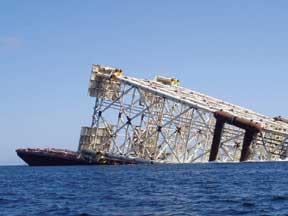 Left: Jacket for the East Azeri platform being launched, March 11, 2006. Photo: BP The goal of the C&WP Community Investment Program was to help ensure sustainable social and economic development for the Bibi-Heybat community through multi-sector, community-based initiatives that strengthen community institutions, build leadership and technical capacity, and improve social and economic infrastructure. These have included a series of micro-projects for rehabilitation of the electricity supply system in Bibi-Heybat, construction of a health care facility and its provision with equipment, construction of a school gym, construction of a first aid station, rehabilitation of a culture centre, renovation of the Bibi Heybat secondary school, rehabilitation of the electricity system of an Internally Displaced Persons settlement, construction of a community centre, a kindergarten and a community park.
Above: The Shah Deniz TPG-500 platform sailed away from the Zykh construction yard in Baku on April 10, 2006. The TPG 500 is a unique achievement for the Caspian. Only two other platforms of this type have ever been built, both of which are operating in the UK North Sea. More than 5,000 people involved in the design, fabrication, construction, transportation and hook up and commissioning. So many countries were involved from Singapore, Norway, France, Germany, USA, Turkey to Azerbaijan. The TPG will be used for gas to benefit the people of Azerbaijan, Georgia and Turkey. Photo: Technip The total cost of the micro-projects was 232,000 AZN (approximately $254,000), of which 27,800 AZN (approximately $30,000) was contributed by the community members with support from the local municipality and executive authorities. Back to Index AI 14.1 (Spring 2006) AI Home | Search | Magazine Choice | Topics | AI Store | Contact us Other Web sites created by Azerbaijan International AZgallery.org | AZERI.org | HAJIBEYOV.com |

